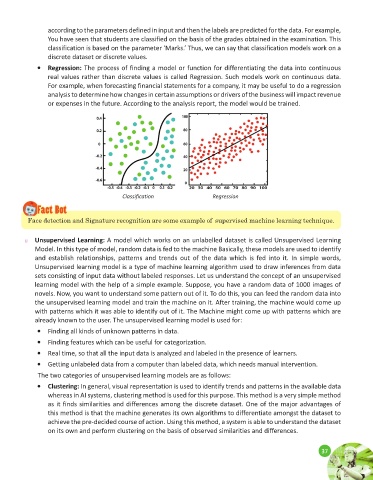Page 163 - Ai Book - 10
P. 163
according to the parameters defined in input and then the labels are predicted for the data. For example,
You have seen that students are classified on the basis of the grades obtained in the examination. This
classification is based on the parameter ‘Marks.’ Thus, we can say that classification models work on a
discrete dataset or discrete values.
z Regression: The process of finding a model or function for differentiating the data into continuous
real values rather than discrete values is called Regression. Such models work on continuous data.
For example, when forecasting financial statements for a company, it may be useful to do a regression
analysis to determine how changes in certain assumptions or drivers of the business will impact revenue
or expenses in the future. According to the analysis report, the model would be trained.
Classification Regression
Face detection and Signature recognition are some example of supervised machine learning technique.
u Unsupervised Learning: A model which works on an unlabelled dataset is called Unsupervised Learning
Model. In this type of model, random data is fed to the machine Basically, these models are used to identify
and establish relationships, patterns and trends out of the data which is fed into it. In simple words,
Unsupervised learning model is a type of machine learning algorithm used to draw inferences from data
sets consisting of input data without labeled responses. Let us understand the concept of an unsupervised
learning model with the help of a simple example. Suppose, you have a random data of 1000 images of
novels. Now, you want to understand some pattern out of it. To do this, you can feed the random data into
the unsupervised learning model and train the machine on it. After training, the machine would come up
with patterns which it was able to identify out of it. The Machine might come up with patterns which are
already known to the user. The unsupervised learning model is used for:
z Finding all kinds of unknown patterns in data.
z Finding features which can be useful for categorization.
z Real time, so that all the input data is analyzed and labeled in the presence of learners.
z Getting unlabeled data from a computer than labeled data, which needs manual intervention.
The two categories of unsupervised learning models are as follows:
z Clustering: In general, visual representation is used to identify trends and patterns in the available data
whereas in AI systems, clustering method is used for this purpose. This method is a very simple method
as it finds similarities and differences among the discrete dataset. One of the major advantages of
this method is that the machine generates its own algorithms to differentiate amongst the dataset to
achieve the pre-decided course of action. Using this method, a system is able to understand the dataset
on its own and perform clustering on the basis of observed similarities and differences.
37
37

